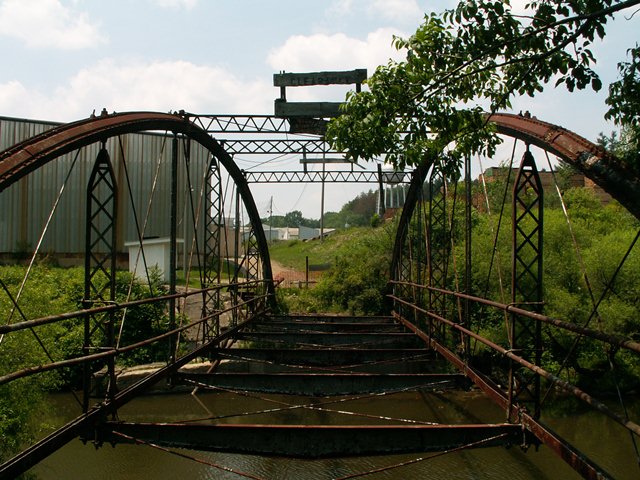We Recommend:
Bach Steel - Experts at historic truss bridge restoration.
Messerall Road Bridge

Primary Photographer(s): Nathan Holth
Bridge Documented: July 1, 2006
East Titusville: Crawford County, Pennsylvania: United States
1876 By Builder/Contractor: Wrought Iron Bridge Company of Canton, Ohio
1960
99.0 Feet (30.2 Meters)
103.0 Feet (31.4 Meters)
14.8 Feet (4.51 Meters)
1 Main Span(s)
207214099330200

View Information About HSR Ratings
Bridge Documentation
This bridge has been relocated. This page and its photos and maps document the former location of the bridge.
Bridge Status: This bridge was relocated to 41.650740, -80.418719 where it received a very low quality repair!This bridge has been relocated and preserved for pedestrian use on Pymatuning State Park Trail.Please also see HistoricBridges.org's page for photos and documentation of the bridge in its current location at Pymatuning State Park Trail.
View Archived National Bridge Inventory Report - Has Additional Details and Evaluation
View Historic American Engineering Record (HAER) Documentation For This Bridge
HAER Data Pages, PDF

While Western Pennsylvania is (or was) known for its large number and rich variety of historic metal truss bridges, one category that the area lacks in is 1870s bowstring truss bridges. This abandoned bridge is one of the only known examples. The bowstring truss bridge, sometimes called a type of arch bridge, is the oldest and rarest type of metal truss bridge that was built in noteworthy numbers, mostly in the 1870s. Unlike the truss bridge designs that came to dominate the truss bridge era later on, these bridges stand on their own as a whole category of truss bridge. They really don't have a lot in common with the appearance of a truss bridge or a typical arch bridge, although in terms of engineering, they combine the physics of each. Despite this level of rarity that makes this bridge more significant than any wooden covered bridge, the Messerall Road Bridge sits abandoned, with its deck removed, just waiting for an abutment to fail or a bad spring flood to send this priceless bridge crashing into the creek.
This bridge is an excellent, and large example of the Wrought Iron Bridge Company version of the bowstring truss bridge. The bridge features a Keystone style top chord column, the most common style of top chord that the company used, based on surviving bridges.
The historic bridge inventory actually had the date for this bridge at 1870, which is impossible, since 1870 was before the patent date of 1873 listed on the plaque. The Historic American Engineering Record provided the correct date of 1876. The date is corrected in the inventory discussion table below.
Information and Findings From Pennsylvania's Historic Bridge InventoryDiscussion of Bridge The single span, 103'-long, bowstring thru truss bridge dates to [1876] and is a rare and remarkably complete example of the Wrought Iron Bridge Company's "column, plate, and channel" design patented by David Hammond, founder of WIBC. An extremely important bridge in the documentation of the development of the metal truss bridge, it was documented by HAER in 1998. Discussion of Surrounding Area The bridge carries 1 lane of a closed road over a stream. It is located immediately behind a modern lumber yard in East Titusvile. Bridge Considered Historic By Survey: Yes |
This bridge is tagged with the following special condition(s): Keystone Columns
![]()
Photo Galleries and Videos: Messerall Road Bridge
Bridge Photo-Documentation
Original / Full Size PhotosA collection of overview and detail photos. This gallery offers photos in the highest available resolution and file size in a touch-friendly popup viewer.
Alternatively, Browse Without Using Viewer
![]()
Bridge Photo-Documentation
Mobile Optimized PhotosA collection of overview and detail photos. This gallery features data-friendly, fast-loading photos in a touch-friendly popup viewer.
Alternatively, Browse Without Using Viewer
![]()
Maps and Links: Messerall Road Bridge
This historic bridge has been relocated and is no longer at this location. See the main bridge page for a link to the new bridge location. This map is shown for reference purposes only.
Coordinates (Latitude, Longitude):
Search For Additional Bridge Listings:
Bridgehunter.com: View listed bridges within 0.5 miles (0.8 kilometers) of this bridge.
Bridgehunter.com: View listed bridges within 10 miles (16 kilometers) of this bridge.
Additional Maps:
Google Streetview (If Available)
GeoHack (Additional Links and Coordinates)
Apple Maps (Via DuckDuckGo Search)
Apple Maps (Apple devices only)
Android: Open Location In Your Map or GPS App
Flickr Gallery (Find Nearby Photos)
Wikimedia Commons (Find Nearby Photos)
Directions Via Sygic For Android
Directions Via Sygic For iOS and Android Dolphin Browser
USGS National Map (United States Only)
Historical USGS Topo Maps (United States Only)
Historic Aerials (United States Only)
CalTopo Maps (United States Only)

